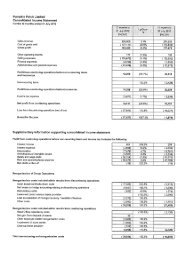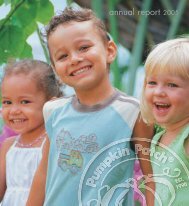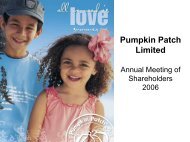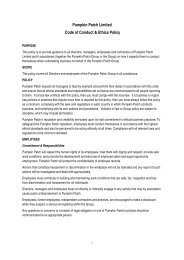Group Financial Statements/Auditors' Report - Pumpkin Patch ...
Group Financial Statements/Auditors' Report - Pumpkin Patch ...
Group Financial Statements/Auditors' Report - Pumpkin Patch ...
Create successful ePaper yourself
Turn your PDF publications into a flip-book with our unique Google optimized e-Paper software.
PUMPKIN PATCH LIMITED & SUBSIDIARIES NOTES TO THE FINANCIAL STATEMENTS 31 JULY 2010<br />
PUMPKIN PATCH LIMITED & SUBSIDIARIES NOTES TO THE FINANCIAL STATEMENTS 31 JULY 2010<br />
1 GENERAL INFORMATION<br />
<strong>Pumpkin</strong> <strong>Patch</strong> Limited (“Company” or “Parent”) together with its subsidiaries (the “<strong>Group</strong>”)<br />
is a leading designer, marketer, retailer and wholesaler of children’s clothing.<br />
The Company is a limited liability company incorporated and domiciled in New Zealand.<br />
The address of its registered office is 439 East Tamaki Road, East Tamaki, Auckland,<br />
New Zealand.<br />
These financial statements were authorised for issue on 22 September 2010 by the<br />
Board of Directors who have the power to amend after issue.<br />
2 SUMMARY OF SIGNIFICANT ACCOUNTING POLICIES<br />
The principal accounting policies adopted in the preparation of the financial statements<br />
are set out below. These policies have been consistently applied to all the years presented,<br />
unless otherwise stated.<br />
(A) BASIS OF PREPARATION<br />
The financial statements have been prepared in accordance with New Zealand Generally<br />
Accepted Accounting Practice (NZ GAAP). They comply with New Zealand Equivalents to<br />
International <strong>Financial</strong> <strong>Report</strong>ing Standards (NZ IFRS), and other applicable New Zealand<br />
<strong>Financial</strong> <strong>Report</strong>ing Standards, as appropriate for profit‐oriented entities. The financial<br />
statements comply with International <strong>Financial</strong> <strong>Report</strong>ing Standards (IFRS).<br />
The principal accounting policies adopted in the preparation of the financial statements<br />
are set out below. The policies have been consistently applied to all the periods presented,<br />
unless otherwise stated.<br />
The reporting currency used in the preparation of these consolidated financial statements<br />
is New Zealand dollars, rounded where necessary to the nearest thousand dollars.<br />
To ensure consistency with the current year, comparative figures have been restated<br />
where appropriate.<br />
Entities reporting<br />
The financial statements for the “<strong>Group</strong>” are the consolidated financial statements<br />
comprising the economic entity <strong>Pumpkin</strong> <strong>Patch</strong> Limited and its subsidiaries. The<br />
financial statements of the Parent are for the company as a seperate legal entity.<br />
Statutory base<br />
The Company is listed on the New Zealand Exchange (NZX). It is registered under the<br />
Companies Act 1993 and is an issuer in terms of the Securities Act 1978. The financial<br />
statements have been prepared in accordance with the requirements of the <strong>Financial</strong><br />
<strong>Report</strong>ing Act 1993 and the Companies Act 1993.<br />
Historical cost convention<br />
These financial statements have been prepared under the historical cost convention,<br />
as modified by the revaluation of financial assets and liabilities, including derivative<br />
instruments.<br />
Changes in accounting policies<br />
The group has adopted the following new and amended NZ IFRSs as of 1 August 2009:<br />
- NZ IFRS 7 <strong>Financial</strong> instruments: Disclosures (amendment) ‐ effective 1 January 2009.<br />
The amendment requires enhanced disclosures about fair value measurement and liquidity<br />
risk. In particular, the amendment requires disclosure of fair value measurements by level<br />
of a fair value measurement hierarchy. As the change in accounting policy only results in<br />
additional disclosures, there is no impact on earnings per share.<br />
- IAS 1 (revised), ‘Presentation of financial statements’. The revised standard prohibits the<br />
presentation of items of income and expenses (that is ‘non‐owner changes in equity’)<br />
in the statement of changes in equity, requiring ‘non‐owner changes in equity’ to be<br />
presented separately from owner changes in equity. All ‘non‐owner changes in equity’<br />
are required to be shown in a performance statement.<br />
Entities can choose whether to present one performance statement (the statement<br />
of comprehensive income) or two statements (the income statement and statement<br />
of comprehensive income).<br />
The group has elected to present two statements: an income statement and a statement<br />
of comprehensive income.<br />
Critical accounting estimates<br />
The <strong>Group</strong> makes estimates and assumptions concerning the future. The resulting accounting<br />
estimates will, by definition, seldom equal the related actual results. The estimates and<br />
assumptions that have a significant risk of causing a material adjustment to the carrying<br />
amounts of assets and liabilities within the next financial year are addressed below:<br />
(i) Impairment of Property, Plant and Equipment<br />
The <strong>Group</strong> undertakes to annually review its assets for indicators that their value is<br />
impaired. Testing for impairment involves judgements and estimates in relation to the<br />
recoverability of asset values. As disclosed in note 4, in 2009 the <strong>Group</strong> performed<br />
impairment testing of its United Kingdom and United States retail stores as well as all<br />
Urban Angel stores, this resulted in an impairment charge being recognised in the 2009<br />
income statement. Following a review of the 2010 operations no indicators of impairment<br />
were identified and as such, no impairment charge was deemed necessary in 2010.<br />
(ii) Inventory<br />
As disclosed in note 2(M), inventories are recorded at the lower of cost and net realisable<br />
value. Assessing the net realisable value of inventory involves making estimates and<br />
judgements in relation to future selling prices.<br />
20<br />
years<br />
young<br />
45












